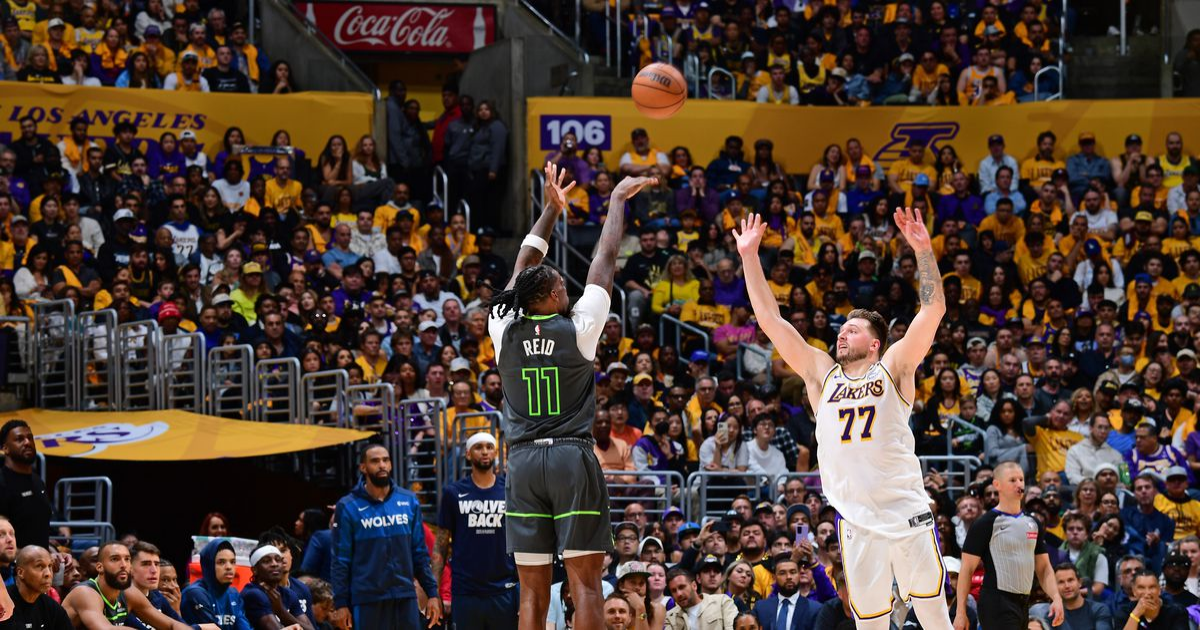The playoffs arrived Saturday evening as the Lakers took on the Minnesota Timberwolves. An early eight-point lead would quickly vanish and the Wolves dominated the contest, ultimately winning 117-95.
Luka Dončić came out hot, scoring 16 points in the first quarter, going 3-6 on 3-pointers. He finished with 37 points but just one assist and five turnovers. Dončić didn’t get much offensive help as Austin Reaves and LeBron James struggled to find their footing.
This loss will certainly linger as the two teams won’t match up again until Tuesday. There is plenty of film for head coach J.J. Redick to analyze.
Let’s explore the three key takeaways from this one.
Lakers need to limit the Wolves’ 3-point shooting.
As expected, the Lakers employed a similar switch-heavy scheme as they did in the previous matchup, providing extra support for Anthony Edwards. They shaded help to encourage him to be a playmaker, creating opportunities for teammates to get open.
The Wolves were better prepared this time, spacing the floor to make it more difficult to help and recover. Edwards hunted Dončić and Reaves on switches, with shooters parked on advantageous spaces on the floor.
Minnesota shot a blistering 21-42 (50%) on threes. Julius Randle and Naz Reid specifically burned them, hitting ten 3-pointers combined. Edwards finished 8-22 from the field, but collected nine assists.
To make matters worse, the Lakers only hit on 7-22 (31.8%) of their threes.
When sending two on the ball, there’s a certain amount of open threes to live with. That said, the rotations and connectivity must improve going into Game 2. Giving a great player the same looks consistently is a recipe for disaster.
Austin Reaves and LeBron James struggle against Minnesota switches.
One of the biggest games of offensive struggles for Austin Reaves and LeBron James came at the worst time. They were out of rhythm from the start as both finished without a field goal in the first quarter.
LeBron and Reaves finished with 19 and 16 points, respectively, with most coming after the lead got out of hand. Reaves finished 5-13 from the field and had just three free throws on the night. LeBron was 8-18 overall and 1-5 on 3-pointers.
The Wolves used some of the Lakers’ medicine against them, switching and baiting them into stagnant one-on-one basketball.
It worked.
LeBron and Reaves targeted mismatches against the Wolves’ big men, settling for difficult step-back jumpers, precisely the shots Minnesota aims to allow.
Los Angeles must find ways to get both going downhill through multiple screen actions. They are more than capable of scoring in isolation, but their offensive rhythm often gets disrupted. The Big 3 for the Lakers had seven assists compared to eleven turnovers, which is a disastrous ratio.
To win Game 2, the Lakers need to find ways to get easier looks and put Minnesota in the blender.
Transition discrepancy
The Wolves dominated the Lakers in transition points, 25-6. Any long rebound or missed shot at the rim prompted them to push the pace and attack the basket, dominating the points in the paint 44-32 as well.
Minnesota already possesses inherent physical athletic advantages and allowing them to leverage those in transition will pose challenges for Los Angeles.
On the other end, six points in transition are nowhere near enough to contend in the series. Minnesota finished sixth in defensive rating thanks to size and perimeter athletes throughout the roster. Consistently going against their set defense will create offensive challenges. L.A needs to find opportunities to force turnovers and play at a quicker pace.
LeBron, Dončić, Reaves and the rest of the team need to find ways to get going in transition for the Lakers to turn their offense around.
You can follow Raj on Twitter at @RajChipalu.
